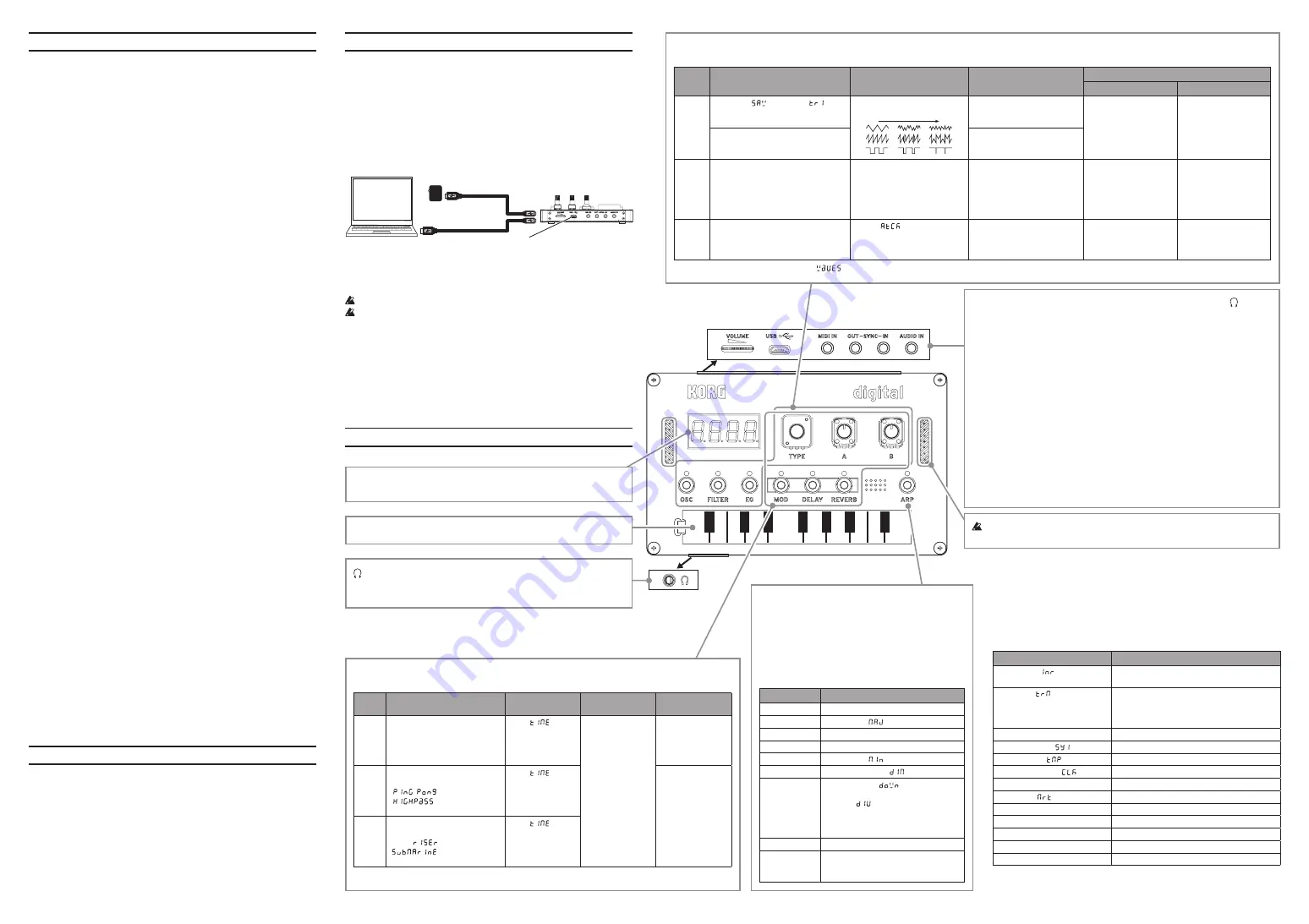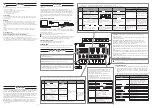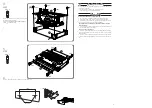
3
4
En
Precautions
Location
Using the unit in the following locations can result in a malfunction.
• In direct sunlight
• Locations of extreme temperature or humidity
• Excessively dusty or dirty locations
• Locations of excessive vibration
• Close to magnetic fields
Power supply
Please connect the designated AC adapter to an AC outlet of the correct volt
-
age. Do not connect it to an AC outlet of voltage other than that for which your
unit is intended.
Handling
To avoid breakage, do not apply excessive force to the switches or controls.
Do not rub your eyes or lick your hands after you have touched the circuit
boards. There may be protruding parts left on the circuit boards from the as
-
sembly process. Be careful not to injure yourself on these parts when operating
this unit.
Care
If the exterior becomes dirty, wipe it with a clean, dry cloth. Do not use liquid
cleaners such as benzene or thinner, or cleaning compounds or flammable
polishes.
Keep this manual
After reading this manual, please keep it for later reference.
Keeping foreign matter out of your equipment
Never set any container with liquid in it near this equipment. If liquid gets into
the equipment, it could cause a breakdown, fire, or electrical shock.
Be careful not to let metal objects get into the equipment. If something does slip
into the equipment, unplug the AC adapter from the wall outlet. Then contact
your nearest Korg dealer or the store where the equipment was purchased.
1.
Pressing the OSC, FILTER and EG buttons will select the corresponding element.
2.
The TYPE knob, and A, B knobs can then be used to set parameters for the selected element.
MODE
buttons
TYPE knob
A knob
B knob
MODE b
A knob
B knob
OSC
Sawtooth (
), Triangle (
),
Square (
s q r
), VPM (
U P N
), User OSC*
Selects the waveform.
Shape (
S H p E
)
Amount of wave-shaping applied.
Alternate (
A L t
)
Alternate parameter (varies per
oscillator)
.
LFO rate: F0.0–F30.0
Sets the LFO frequency.
Pitch/shape LFO depth:
P100–P001, --, S001–S100
Sets the amount of pitch
or shape modulation.
<When selecting User OSC*>
OSC+TYPE selects edit parameters
(varies per oscillator).
<When selecting User OSC*>
Sets the value of the selected
edit parameter.
FILTER
Low pass-2 pole (
L p 2
), Low pass-4
pole (
L p 4
), Band pass-2 pole (
b p 2
),
Band pass-4 pole (
b p 4
), High pass-2
pole (
H p 2
), High pass-4 pole (
H p 4
),
OFF (
o f f
)
Selects the filter type.
Cutoff (
C u t F
)
Sets the cutoff frequency,
altering the brightness of the
sound.
Resonance (
r E s o
)
Adds emphasis to the
overtones occuring at the
cutoff frequency.
Sweep rate: F0.0–F30.0
Sets the cutoff sweep
frequency.
Cutoff sweep depth:
u100–u001, --, d000–d100
Sets the direction (up/
down) and depth of the
cutoff sweep.
EG
ADSR (
A d s r
), AHR (
A H r
), AR (
A r
),
AR loop (
A r L o o p
), Open (
o P E n
)
Selects the amplitude EG type.
Attack (
)
Sets the time required for the EG
to reach it’s maximum level once
a note is played.
Release (
r E L s
)
Sets the time required for the
EG to reach 0 once a note has
ended.
Tremolo rate: F0.0–F60.0
Sets the tremolo
frequency.
Tremolo depth: d000–
d100
Sets the tremolo depth.
* User OSC: Comes preloaded with “
”. For details about User OSC see the Nu:Tekt web site (www.nutekt.org).
Introduction
Thank you for purchasing the Nu:Tekt programmable synthesizer kit NTS-1
digital kit.
The NTS-1 digital kit is a compact DIY synthesizer kit that can be
assembled without any soldering. It features a digital oscillator inspired
by the prologue and minilogue xd; an analog modeled multimode filter;
an analog modelled envelope generator; as well as modulation, delay and
reverb effects. It is compatible with the logue SDK, making it possible to
load your own custom oscillators and effects, or those created by third
parties.
Connections and power
Commercial USB AC adapter (USB 2.0 compatible)
NTS-1 digital kit
USB cable
USB port
Computer
Use the included USB cable to connect the USB port of the NTS-1 digital
kit to computer or a commercial AC adapter conforming to USB standards
(DC5V 550 mA or higher).
Power will turn on, and the device will enter play mode.
Use only the USB cable provided.
Be sure to use an AC adapter that conforms to USB2.0 standards. However,
there may be cases where, depending on the USB AC adapter used, it will
not function normally even when compatible with the standards.
Turning off the power
Disconnect the USB cable from the NTS-1 digital kit.
Once disconnected all LEDs will go dark (unlit).
SLEEP MODE
After 15 minutes of inactivity the device will enter sleep mode. Press the
OSC button to wake up the device and return to normal operation.
Global Parameters
1.
While holding down the REVERB button, turn on the NTS-1 digital kit.
2.
Select a global parameter with the TYPE knob and change its value
with the B knob. The current value is displayed on the right side of
the display. If you decide to cancel the settings, press the REVERB
button.
3.
When you have finished specifying the settings, press the ARP button.
The settings will be saved, and the NTS-1 digital kit will be restarted.
TYPE knob
B knob
Input route (
)
0*: before mod, 1: before delay, 2: before
reverb, 3: before master, 4: after master
Input trim (
)
0: 0dB, 1: -1dB, 2: -2dB, 3: -3dB, 4: -4dB,
5: -5dB, 6*: -6dB, 7: -7dB, 8: -8dB, 9: -9dB,
A: -10dB, B: -12dB, C: -16dB, D: -24dB,
E: -48dB, F: -64dB
Sync out polarity (
S Y o
)
0*: active high, 1: active low
Sync in polarity (
)
0*: active high, 1: active low
Tempo range (
)
0*: narrow, 1: wide
MIDI clock source (
)
0: internal, 1*: auto
MIDI RX/short message (
S H r
)
0: off, 1*: on
MIDI route (
)
0*: USB+MIDI, 1: USB
MIDI channel (
C H n
)
0*–F: 1–16
Sync in/out unit (
S t P
)
0*: 2step, 1: every step
EG Legato (
L G t
)
0: off, 1*: on
Sleep mode (
S L P
)
0: off, 1*: on
Touch sensor calibration (
C A L
) See
the Nu:Tekt web site
*: Factory default setting
Ribbon keyboard
: Press with your fingers to play sounds.
Parts and their functions
(Headphone) jack
: Connecting your headphones to this 3.5mm
stereo mini jack will mute the NTS-1 digital kit internal speaker and
allow you to create music in private.
VOLUME
: Sets the volume of the signal output to the speaker and
(Headphone) jack.
AUDIO IN jack
: Stereo audio input. The gain trim and mix route can be set
using global parameters.
IN–SYNC–OUT (SYNC IN, SYNC OUT) jacks:
These jacks allow you to
synchronize your NTS-1 digital kit to a Korg volca, monotribe or other
equipment—including an analog sequencer or a DAW. The polarity of the
SYNC jacks can be set using the global parameters.
SYNC OUT jack
: A 5 V pulse of 15 ms is sent at the beginning of each step.
SYNC IN jack
: If this jack is connected, the internal step-clock will be ignored,
and the NTS-1 digital kit ARP will advance according to the pulses received
here.
MIDI IN jack
: By connecting a MIDI cable to this input, the NTS-1 digital kit can
be played and controlled by the MIDI output of an external device (See the
Nu:Tekt web site). The MIDI implementation chart can be downloaded from
the Nu:Tekt website.
USB port
: Use this USB port to connect the NTS-1 digital kit to your computer,
or to a commercial USB power source.
A single press on the ARP button will toggle the
arpeggiator on (LED lit) and off (LED unlit).
When enabled, the arpeggiator will run while the
ribbon keyboard is pressed.
A long press on the ARP button will latch the
arpeggiator. To unlatch the arpeggiator, long press
the ARP button again.
While holding the ARP button, the TYPE, A and B
knobs can be used to set arpeggiator parameters.
ARP b
Arpeggiator settings
OSC
button
Octave (
o C t
)
FILTER
button
Major Triad (
)
EG
button
Major Suspended (
s u s
)
MOD
button
Major Augmented (
A u G
)
DELAY
button
Minor Triad (
)
REVERB
button
Minor Diminished (
)
TYPE
knob
Up (
u p
), Down (
), Up-Down (
u - D
),
Down-Up (
d - u
), Converge (
C o n U
),
Diverge (
), Conv.-Div. (
C - D
),
Div.-Conv. (
d - C
), Random (
r A n d
),
Stochastic (
S t o C
)
Selects the arpeggiator pattern.
A
knob
ARP pattern length: 1–24
B
knob
If synced externally, sets the step
duration: 16th–64th.
Otherwise, sets the tempo: 56.0–240.0
Specifications
Keyboard
: Ribbon keyboard,
Sound generator system
: 1 VCO, 1 Multimode
filter, 1 EG, 3 LFO,
Effects
: MOD (CHORUS, ENSEMBLE, PHASER, FLANGER),
REVERB, DELAY,
Input/output jacks
: Headphone jack (3.5 mm stereo
mini-phone jack), AUDIO IN jack (3.5 mm stereo mini-phone jack), SYNC IN
jack (3.5 mm TRS mini-phone jack, 20V maximum input level), SYNC OUT
jack (3.5 mm TRS mini-phone jack, 5V output level), MIDI IN jack (3.5 mm
TRS mini-phone jack), USB port (micro B type),
Power supply
: USB bus power mode,
Current consumption
: 500 mA or less,
Dimensions
(W
×
D
×
H): 129 mm
×
78 mm
×
39 mm / 5.08”
×
3.07”
×
1.54”,
Weight
: 124 g / 4.37 oz,
Included items
: USB cable, Owner’s manual
* Specifications and appearance are subject to change without notice for
improvement.
1.
Pressing the MOD, DELAY and REVERB buttons will select the corresponding effect.
2.
The TYPE knob, and A, B knobs can then be used to set parameters for the selected effect.
FX
buttons
TYPE knob
A knob
B knob
FX b B
knob
MOD
OFF (
o f f
), Chorus (
C H o r u s
),
Ensemble (
E n s E N b L E
),
Phaser (
P H A s E r
), Flanger
(
F L A n G E r
)
Selects the modulation effect.
Time (
)
Sets the modulation
speed.
Depth (
d p t H
)
Sets the intensity of
the effect.
-
DELAY OFF (
o f f
), Stereo (
s t E r E o
),
Mono (
N o n o
), Ping Pong
(
), High Pass
(
), Tape (
t A p E
)
Selects the delay effect.
Time (
)
Sets the delay time.
Dry/wet mix: d100–
d001, --, w001–w100
Sets the dry/wet
balance of the
effect.
REVERB OFF (
o f f
), Hall (
H A L L
),
Plate (
p L A t E
), Space (
S p A C E
),
Riser (
), Submarine
(
)
Selects the reverb effect.
Time (
)
Sets the reverb time.
For details about User effects see the Nu:Tekt web site (www.nutekt.org).
Be careful not to touch the metal connections, as it can cause short
circuits and failures.
Display
: When operating knobs and buttons, the parameter name or
value will be displayed.




